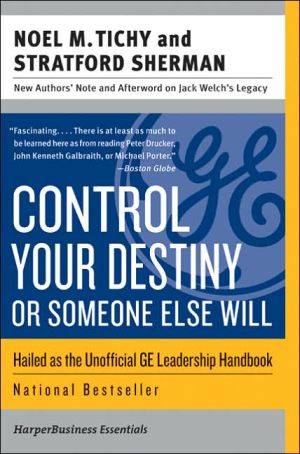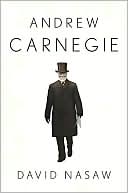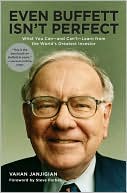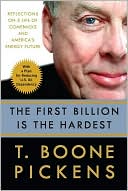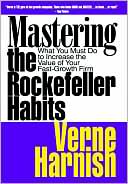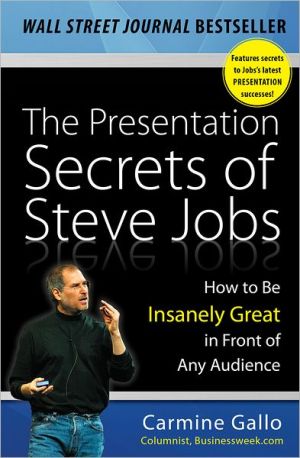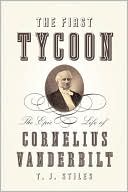Control Your Destiny or Someone Else Will
Acknowledged as the outstanding business leader of the late twentieth century, Jack Welch made General Electric one of the world's most competitive companies. This dynamic CEO defined the standard for organizational change, creating more than $400 billion in shareholder value by transforming a bureaucratic behemoth into a nimble, scrappy winner in the global marketplace.\ Here, Tichy and Sherman extract the enduring leadership lessons from the revolution Welch wrought at GE. Of these, the...
Search in google:
The Six Rules Jack Welch Lives By: Control your destiny or someone else will. Face reality as it is, not as it was or as you wish it were. Be candid with everyone. Don't manage, lead. Change before you have to. If you don't have a competitive advantage, don't compete.With these basic principles, Jack Welch of General Electric rewrote GE's corporate DNA, transforming it from a dinosaur to a nimble, highly adaptive competitor -- one of the biggest winners in the global marketplace. Now this completely revised edition of the landmark study of his management principles shows how anyone can succeed with Welch's ideas.
Introduction\ The cult of Jack Welch is so firmly established that it is enlightening to recall how little admired he was during the early 1990s, when Noel Tichy and I were writing the first edition of this book. By early 2001, as Welch's retirement approaches and chairman-elect Jeffrey Immelt prepares to take charge, GE's zestful chief executive has taken on almost godlike prestige. Fortune, which once excluded General Electric from its list of most admired companies, now calls John F. Welch Jr. the manager of the century. The Financial Times names GE the most respected company in the world. On 60 Minutes, Welch is lauded as the best executive in the world and gets credit for personally stimulating the 1990s boom in the U.S. economy. GE is honored as the world's best school for business leaders, as its famously effective managers win CEO jobs at a long list of eminent companies that has expanded to include Home Depot and 3M.\ With a recent market capitalization of $450 billion (it was $13 billion when Welch became CEO in 1981) GE is the most valuable company traded on the New York Stock Exchange, as well as the second most profitable business (after Citigroup) in the S&P 500. If GE unexpectedly manages to close its acquisition of Honeywell, the combined company would employ more people than GE did two decades ago -- and as Welch is delighted to note, GE employees now collectively own the largest block of GE stock. For the guy once dismissed as "Neutron Jack," the ambitious train conductor's son who remembers growing up with his "nose pressed against the glass," this is heady stuff. As Welch told us, "I am onelucky guy."\ We were sailing into the wind when Control Your Destiny or Someone Else Will was published in 1993. Although by then Welch's reputation was improving, our view of GE's transformation as the best model for business leaders worldwide proved extremely controversial. If we were not actually pelted with tomatoes and rotten eggs, we certainly were viewed with suspicion and fierce disapproval. We were championing a competitive approach that undeniably resulted -- at least in the short term -- in lost jobs, high worker stress, ruthless abandonment of obsolete businesses, and purposeful overturning of the status quo. Back then, remember, the happy ending of soaring productivity, job creation, energized employees, sustainable profit growth, and widespread prosperity had not yet played out.\ Nonetheless, this book found its audience, just as Welch found his. Whether through fate or genius, Welch's thinking consistently has proved relevant to the times. "The New Economy," wrote the Wall Street Journal in 2001, "is about more than just technology and the Internet. It is about old-line companies finding whole new ways to communicate and operate more efficiently." GE, founded by Thomas Edison in 1878, became a New Economy archetype, setting standards of excellence in advanced technologies and in what Welch calls "social architecture." Gradually, people noticed.\ Reconsidering Welch and GE in 2001, we reassert that almost anyone can learn something valuable by studying them. We are not cultists, though. We recognize that neither Welch nor GE is perfect and also that some of their appealing attributes are unique, inimitable. Few leaders can match Welch's charisma, energy, and clarity of purpose. Few companies can match GE's vast economic clout, the wealth of ideas it derives from diverse operations, or the discipline and ability to manage complexity that already distinguished the company back in 1960, when Welch drove his Volkswagen Beetle to Pittsfield, Massachusetts, for his first GE job.\ As the personification of the new GE, Welch has received more than his share of attention. In person, he is vibrant, blue-eyed, fit, and sizzling with energy. Vitality is his most striking feature: Welch always seems to be enjoying himself -- even when he's annoyed -- and his intensity, his seething aliveness, the delight he takes in every breath, make him magnetic. Welch is the first to remind others that GE is not a one-man show. Of course that's true -- it's an understatement -- yet the peculiar workings of Welch's mind, his gifts as a communicator, and the force of his will have made essential contributions to the company's transformation. Perhaps the most carefully reasoned measure of Welch's value is his pay: For 2000, the most recently reported year, GE awarded its CEO total compensation of $76 million, including exercised stock appreciation rights.\ Although this story does appear to end happily, it is not a fairy tale. Welch and GE certainly deserve their share of criticism. Burnout remains an intractable problem for many hard-driving GE employees. Despite substantial progress in creating a more diverse work force, GE still has a top echelon dominated by white American males. Welch, though known for his love of intellectual conflict, sometimes seems isolated by the cocoon of adulation that has thickened around him in recent years. And while GE, once scandalprone, has established a high standard of integrity, the company still outrages many environmentalists by firmly asserting its rights in controversies such as the debate about how to handle PCB pollution in New York's Hudson River.\ Far more significant and relevant to the purpose of this book, however, is GE's controversial role as avatar of brutal global competition. During the 1980s and 1990s, while other top U.S. corporations were getting killed in the marketplace, GE kept winning. Other CEOs complained about drastic marketplace change; Welch responded to it. This is the enduring value of the GE story: It demonstrates a successful method for adapting to new realities. So long as the world continues to turn, this will remain a precious skill.\ In the tranquil decades following World War II, business was essentially an intramural sport, the United States' principal economic rivals having been bombed to rubble. This game was played, mostly within national borders, by a limited number of contenders, such as General Motors, Ford, and Chrysler in the automobile market. The companies followed a set of gentlemanly rules. Paternalistically, they insulated employees from direct experience of marketplace combat, offering lifetime job security in return for loyalty and hard work. In this game, nobody lost. Everybody won.\ This cozy system exploded in the 1970s, just as Welch was climbing the ladder at GE. Germany and Japan, having built new, state-of-the-art factories, invaded the U.S. market, dazzling consumers and dismaying competitors with high-value offerings such as Sony TVs and BMW cars. Suddenly, competition was no longer a low-stakes game. As globalization dawned, markets began to transform dramatically. Operating in this unfamiliar environment, many U.S. companies, hindered by high costs, closed-minded bureaucracies, and inward-looking cultures, became losers. Jack Welch became CEO of GE absolutely determined to win. Recognizing how much the world had changed, he responded with asset sales, job cuts, and bold initiatives that shocked people inside the company and out.\ Ever since, Welch has dedicated himself to what might be called competitive transparency. He worships the marketplace, accepting its judgments as supreme. Therefore, he accepts the cruelties of global competition as a given, not a cause for protest. He consciously tries to eliminate anything that insulates GE's businesses or employees from the markets on which their well-being jointly depends. By thus connecting minds to markets, Welch has sought to align the goals of the company and its people, while energizing the enterprise and making it as responsive as possible to customers -- who are, after all, the market's representatives. That is why Welch has so aggressively shared information and seized so many opportunities to communicate. He wants every GE employee to share his direct experience of competition, to feel it the way a sports car driver feels the road. Similarly, he wants everyone at GE to internalize and contribute to the company's values and goals.\ Always yearning for marketplace advantage, Welch seeks opportunities to redefine the terms of competition. He calls this "changing the game." Early on, he relied on improved productivity: Once GE became the low-cost competitor in an industry such as lighting, it gained the freedom to decide unilaterally whether to gain more market share by lowering its prices, or to leave pricing unchanged and enjoy fatter profit margins instead. From the start of his career, Welch also has used advanced technologies to change the game, whether by producing high-value plastics with unique properties, designing more fuel-efficient jet engines, or lowering GE's purchasing costs through use of Internet auctions. As time went on, Welch came to regard GE's increasingly informal culture as yet another way to change the game. Always an enemy of pretension, Welch views informality -- candor, quick decision-making, freedom from bureaucracy, an atmosphere of hopped-up collegiality -- as GE's secret weapon. He told us, "If the company weren't informal and the people weren't engaged, none of our best practices would amount to much. No one really understands how valuable an informal company is; it's critical to understand that."\ The theory is that if everyone understands everything, decision-making becomes laser precise and lightning fast. Even an enterprise with revenues approaching $130 billion, as GE's did in 2000, would respond instantly, delightfully, to the individual customer's every twitch. Technology, particularly the Web-based communications systems that Welch has embraced of late, vastly increases the transparency of business, by giving customers real-time access to information, such as product inventories, that formerly was squirreled away in file drawers or offline computers. Welch revels in the trend toward unfettered competition and ubiquitous access to information, because that is the game GE has learned how to win.\ As the 1990s progressed, GE's example inspired other businesses, particularly in the U.S. at first, to drastically reshape themselves for the new competitive era. This is why some observers credit Welch for contributing to the country's economic renaissance. Surely global competition would have emerged without any help from Welch, but perhaps the U.S. would have prospered less without his timely influence.\ Since the new competitive game produces clear winners and losers, inevitably a substantial number of people feel disadvantaged by it. Jack Welch and GE didn't invent job stress or worker vulnerability, nor have they solved these problems. What they have done, rather, is to embody the era in which these issues emerged.\ Our hope is that a discriminating understanding of the GE story will help people in all walks of life to control their destinies. Underlying the developments described in this book is a coherent approach to business, and life, that anyone can adopt. Don't try to reproduce what GE has done -- learn from it. Companies trying to emulate GE often copy specific behaviors and practices, without absorbing the core ideas and understandings on which they're based. Such misguided imitators usually end up with the broken shell of the nut, and little of its meat. Some GE practices, such as the Six Sigma approach to quality, can be dauntingly complex. Others, such as the "GE operating system" that produces so many outstanding leaders, require a sophisticated feel for human behavior. To produce great results, even the simplest of GE's practices demands a level of persevering commitment and a concentrated massing of resources that are hard to maintain without deep understanding of their purpose. So if others find they cannot mimic Welch's successes, perhaps they have not yet imbibed the basic ideas that underlie every one of the CEO's accomplishments.\ Welch's philosophy -- which he apparently received from his mother, Grace -- is not complicated. It boils down to: Face reality and adapt. Those who would follow this model may start, as Welch did, with a radical, unblinking acceptance of the world, and themselves, as they are right now. That is the substance of the CEO's familiar exhortation: "Face reality as it is, not as it was or as you wish it were." From this fundamental dictum inevitably follows the idea of response. Anyone who faces reality cannot fail to see the need to adjust, endlessly and often dramatically, to actual circumstances. Thus the second half of Welch's philosophy is the ferocious imperative to change. That's really all there is to it. Anyone who fully commits to facing reality and adapting, and who has the guts, brains, and integrity to relentlessly fulfill that commitment, will benefit from the same infinitely powerful inner engine of transformation that created the man and the company we so admire today.\ This new edition of Control Your Destiny, written in response to intensifying interest, is updated to accommodate events through year-end 2000. We have revised the financial information throughout, to help readers see the long-term impact of GE's transformation, and expanded the GE Timeline, which relates the company's progress to world events. However, our main focus intentionally remains on the crucial first phase of Welch's tenure as CEO, 1981-1993, during which he carefully laid the groundwork for all that has followed.\ We have added four new prisms through which to view the ongoing GE story. This Introduction offers a broad perspective on the Welch era at GE. In a long interview presented in Chapter 20, Welch candidly reviews his decades as CEO and details his thinking about the initiatives that have made GE great. This interview was recorded in late 1999. In Chapter 21, Noel Tichy reviews and updates the whole GE story; he also assesses the Welch legacy, with particular emphasis on leadership development. Finally, we provide all of Welch's annual letters to share owners from 1981 through 2000; these letters have constituted the CEO's most complete and detailed public explanations of his leadership. When read as a collection, they reveal the step-by-step evolution of his thinking.\ As Welch explains in Chapter 20, he has relied on a series of initiatives to transform GE. The first was reform of the company's business portfolio, with the now familiar demand that each operation be No. 1 or No. 2 in its market. By 2001, he had moved all the way to "digitization," the effort to use Internet communications to get closer to customers and make internal systems more efficient. The digitization push didn't stop GE from attempting the Honeywell deal, a huge transaction initially valued at $48 billion that provoked resistance from the European Commission. What is fascinating to observe, in retrospect, is the care and patience with which the impatient Welch has nurtured each of GE's initiatives. He planted them one by one, finding ways to nourish each one as it took life and became self-sustaining. He has stuck by every one of these initiatives, repeating the same simple messages again, and again, and again.\ Over time, each effort has won converts who, in turn, have contributed their own ideas and whose successes have inspired still others. Thus for all our emphasis on Welch, the true heroes of this story are the GE employees who have brought his ideas to life.\ GE's initiatives have altered the state of mind and beliefs of GE people worldwide. Consider the Work-Out program (described in Chapter 16), which began in 1988 as a way to make hierarchy less of a barrier for ideas. Once Work-Out had got ordinary workers speaking openly to managers a couple of levels above their own supervisors, something surprising happened. People began to notice other barriers to surmount. They asked why lines of business, or geography, should inhibit communication. Why not invite suppliers and customers into the intimacy of GE's candid discussions? Thus Work-Out eventually, unexpectedly, spawned the explicit value of "boundaryless" behavior, which we also discuss at length in Chapter 18. In essence, boundarylessness is the refusal to accept any limitations to the free exchange of information and ideas. It is the complex set of behaviors that permits GE to make the most of its brainpower. Emphasizing the importance of boundarylessness, GE has reinforced this value by firing people who don't share it, such as supervisors who bully their subordinates. That is typical Welch: He found a very simple -- and wholly unsentimental -- way to clearly communicate his intention to GE's hundreds of thousands of employees. Steadily, purposefully, GE has been distilling its employee population into a group of people who know how to benefit from candor and shared information. The state of mind of this population is what makes GE, as an organization, so adept at learning.\ As this example suggests, the best of Welch's achievements can be hard to imitate directly, because they result from subtle processes. The first subtlety is that the line from idea to result almost never is straight. GE's initiatives tend to evolve, in an unpredictably organic process. Welch did not launch Work-Out to create a learning organization. His initial goals were limited: He just wanted the guys who designed locomotives to listen to the factory workers who actually built them. It seemed stupid not to solicit ideas from the low-level employees who knew how their jobs got done. What took Work-Out so very far beyond its modest initial goals was Welch's own delight in learning, his own adaptability. As feedback from the program began to reach him, he adapted, integrating his new understanding into revisions of the program. The heads of GE's business units, who had been selected in part for their ability to learn and adapt, behaved similarly. In theory, every member of GE's hierarchy would behave this way, permitting new ideas to cascade through the whole system. That ideal may remain distant, but after two decades of Welch leadership, GE certainly has become more responsive to feedback, enabling the company's initiatives to evolve with increasing speed.\ A second subtlety of the GE process concerns the way GE masses its resources. When Welch commits to a program, he commits absolutely. GE will give up if a path becomes a dead end, but until then the team does everything it can to make an initiative succeed. For example, early on, Welch knew he wanted to change the GE culture and the behavior of its people, so he invested heavily in Crotonville, the company's management school; indeed, he has taught there in person for twenty years. Most CEOs would have stopped at that -- at the boundaries of the company's formal training center. Not Welch. He drew on resources regardless of their location.\ He kept tinkering with the so-called GE "operating system," the interlocking set of processes for managing the company, until it could comprehensively support his goal of leadership development. As this book explains, Welch's team redesigned GE's existing compensation system, spreading stock options through the ranks to motivate high performance. They created new measurements, such as explicitly ranking people on the values of boundarylessness, and tied those measurements to compensation. They transformed the appraisal process, insisting that managers identify and eliminate the bottom 10% of their subordinates. In the process known as Session C, Welch personally has reviewed the careers of GE's top 500 people every year, using job assignments, as a lever to influence their behavior. The more one looks, the more one finds coordination and integration in GE's approach. As the integrated systems and massed resources produced results, the range of possibilities perceived by GE leadership vastly expanded, and so did the ambition of their initiatives. The GE experience thus demonstrates how total commitment can lead to extraordinary results.\ Since the first edition of this book was published in 1993, a great many important events have taken place at GE. Welch has launched major new initiatives in service, Six Sigma, and digitization. A long-standing globalization effort, which started slowly, has gained traction. While other lines of business had ups and downs, the financing unit now known as GE Capital Services has flourished, contributing 40% of net income in 2000. Investor enthusiasm has pushed the company's price/earnings multiple from 19 times earnings in 1993 to a recent 36, compared to 21 for the S&P 500 and roughly 15 for financial companies. Meanwhile, the GE culture has been evolving into an intelligent and self-perpetuating organism that advances and integrates new ideas, enhances its constituents' abilities, and produces results that exceed even the CEO's expectations. As Welch's term of office approached its end, he orchestrated not only his meticulously planned succession but the surprise Honeywell deal, which could become the biggest of GE's countless acquisitions over twenty years or a memorable misstep.\ The following are major initiatives and events since 1993:\ \ Services: This initiative began in response to the relatively slow growth of many of the industrial markets GE has served, such as light bulbs and aircraft engines. With a limited upside in product sales, GE needed other sources of revenue. At first, the service initiative was meant to ensure that GE units recognized, and got credit for, the services they already were providing to customers. Then GE instructed its product designers to build in new service opportunities, such as easy software upgrades for the diagnostic-imaging equipment that hospitals buy. By year-end 2000, service offerings (including GE Capital's financial services) produced 70% of GE's total revenues.\ Six Sigma: This is another way GE squeezes more value from its operations. Six Sigma is a statistical measurement of how much a process varies from perfection. One sigma signifies 690,000 defects per million units. "Six sigma" stands for 3.4 defects per million, or a success rate of 99.99966%. The Six Sigma initiative is a rigorous, data-intensive effort to bring the output of business processes up to that standard of near perfection. GE has invested $2.1 billion in this project over five years. Since more reliable products make customers more efficient, they command higher prices; reducing downtime and scrap in GE's own processes lowers the company's costs. In such ways, Six Sigma has generated returns of $7.1 billion. As Welch explains in his 1999 interview (see Chapter 20), GE is training perhaps 30,000 of its most promising executives as Six Sigma "black belts"; through them, Six Sigma is thus becoming yet another instrument of cultural change.\ Digitization: GE was late to recognize the importance of electronic commerce, the emergence of which Welch has described as the biggest business event of the last 100 years. "My age and my experience were against me on this one," he told us. But once he understood the opportunity, GE jumped in. Led by Plastics, Power Systems, and NBC, the company began launching websites. Every business participated in the initiative Welch dubbed "destroyyourbusiness.com," finding opportunities to bring their business processes on-line before high-tech competitors could discover and exploit their vulnerabilities. (The program was later renamed "growyourbusiness.com.") During 2001, GE expects to conduct 30% of its purchases from outside vendors on-line, at substantial savings, while gaining fully 15% of its revenues from on-line sales.\ Succession: As Welch explains in Chapter 20, the effort to identify his successor formally began in 1991. Among the most obvious candidates initially were GE's business heads, all but one of whom already were chief executives of operations with multi-billion-dollar revenues. In contrast to the famous process through which GE had selected Welch from a short list of contenders working at headquarters, the candidates this time remained in operating roles, in locations such as Evandale, Ohio, and Waukesha, Wisconsin. Seeking a congenial team, Welch discouraged overt competition among them. Groups of GE directors fanned out to spend a day with each candidate and reported their impressions to Welch. The CEO invited candidates to informal tête-à-tête dinners, asking them for not only their visions but their feelings about other GE executives.\ In November 2000, GE named Welch's successor: Jeffrey R. Immelt, then forty-four. As head of GE's burgeoning, $7 billion-per-year Medical Systems unit, which makes diagnostic equipment such as CT scanners, the tall and informal Immelt had aggressively promoted initiatives such as Six Sigma and digitization, while getting superior results from his people. The other two finalists also had great records and soon took CEO posts outside GE: Robert L. Nardelli, of Power Systems, which makes turbines, joined retailer Home Depot, and W. James McNerney Jr., of Aircraft Engines, went to Minnesota Mining and Manufacturing, known as 3M.\ Honeywell: This unexpected deal, announced just a month before GE named Immelt chairman-elect, was classic Welch. A spontaneous response to marketplace events, it showcased GE's ability to move quickly and, at least within GE's top ranks, certainly changed the game. GE had had its eye on Honeywell for years. Lawrence A. Bossidy, a former GE vice chairman and longtime Welch associate, had led a GE-style transformation of Honeywell's predecessor, AlliedSignal, an industrial conglomerate with interests in plastics, chemicals, and auto parts. In 1999 AlliedSignal bought Honeywell, another old company in need of revitalization, and assumed its name. Bossidy then retired, replaced as CEO by Michael R. Bonsignore. The new Honeywell's business lines meshed nicely with GE's, but Honeywell was not yet producing outstanding financial results. So when United Technologies -- which competes with GE in jet engines -- decided to buy Honeywell, Welch quickly crunched the numbers on a competing bid. The math worked out, and the rest is history.\ What stunned people inside GE and out was Welch's agreement to stay on extra months as CEO, at Bonsignore's request. The move is controversial: Serving so long as apprentice to the manager of the century seems awkward for GE's chairman-elect and risks tarnishing Immelt's prestige. On the other hand, the challenge facing Welch's successor would have been hair-raisingly complicated even without the additional task of integrating an underperforming, $25 billion-per-year acquisition. As this book went to press, the deal was in jeopardy, its outcome uncertain.\ \ It is hard to say whether GE or the outside world has changed more during the two decades since Jack Welch became CEO of General Electric. In 1981, as Welch recalls, U.S. inflation seemed out of control, Japan seemed to be on the verge of dominating the global economy, and the price of oil seemed headed for $100 per barrel. Two decades later, as Welch was preparing to retire, the inflation rate was negligible, the Japanese economy was weak, and oil prices, though rising again, seemed almost unimportant. During the entire period of Welch's leadership, no matter what was happening in the outside world, General Electric found ways to thrive, producing record profits in almost every fiscal quarter. This, finally, is what Welch has wrought at GE: a company that can prosper in any environment.\ In free-market capitalism, the ultimate duty of a corporate leader is to enrich the share owners. When other leaders were muddled, Welch lucidly focused on his duty, rigorously and consistently aligning his actions toward achievement of this one goal. He did his best to face reality and adapt. He pushed hard, and when he saw opportunities, he grabbed them, without worrying much about whether people might disapprove. Along the way, he tried to remain open-minded, to keep learning all the time. If he has won widespread approval, perhaps it is because his words and actions have integrity. He has done what he said he would do.\ Stratford Sherman\ March 2001\ Control Your Destiny or Someone Else Will. Copyright © by Noel M. Tichy. Reprinted by permission of HarperCollins Publishers, Inc. All rights reserved. Available now wherever books are sold.
\ From Barnes & Noble1. Control your destiny, or someone else will. 2. Face reality as it is, not as you wish it were. 3. Be candid with everyone. 4. Don't manage, lead. 5. Change before you have to. 6. If you don't have a competitive advantage, don't compete. A quarter of a million copies later, the force of this book's six basic ideas still endure, and the two chapters added for this edition only increase its worth. Readers of Jack Welch's Jack will enjoy this clear and snappy summary of the precepts of the savvy genius of General Electric.\ \
